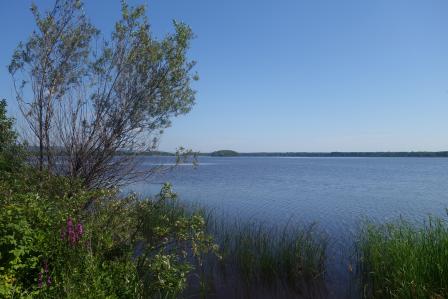Highlights
Spirit Lake sediment cleanup and restoration open house, March 4, 2020 at Morgan Park Community Center
- A presentation for the final design with posters.Exit
 EPA, working with U.S. Steel is completing a remedial design that combines dredging, capping and on-site disposal to clean up contaminated sediment in Spirit Lake, a section of the St. Louis River near Duluth.
EPA, working with U.S. Steel is completing a remedial design that combines dredging, capping and on-site disposal to clean up contaminated sediment in Spirit Lake, a section of the St. Louis River near Duluth.
While the massive Duluth Works steel plant operated, it released a variety of pollutants into Spirit Lake, including polycyclic aromatic hydrocarbons, or PAHs, and heavy metals including lead, copper and zinc.
EPA and U.S. Steel have been working in partnership under the authority of the Great Lakes Legacy Act to develop a comprehensive plan to clean up contaminated sediment. EPA and U.S. Steel reviewed potential cleanup alternatives. Their experts believe this proposed plan is the best way to manage potential risks to human health and the environment posed by the pollution.
The cleanup plan
The remedial design consists of a combination of commonly used sediment cleanup technologies. These include dredging, in-place capping, thin-layer capping, and on-site disposal in confined disposal facilities. All technologies have been used for decades throughout the Great Lakes for the successful cleanup and disposal of contaminated sediment.
The planned project includes dredging of about 697,000 cubic yards of contaminated sediment. The sediment will be disposed of at the former Duluth Works location. It will go into disposal facilities constructed on a portion of mud flats next to an unnamed tributary as well as on upstream areas next to the tributary.
The plan also caps around 132 acres of lightly contaminated material in the St. Louis River Estuary. The dredging will result in aquatic ecosystem improvement through the creation of 30 acres of new, open water, increased fish spawning habitat and improved public access to the river.
The evaluation of alternatives and the proposed plan are detailed in the feasibility study and feasibility study addendum below.
About the site
The Spirit Lake, Former U.S. Steel Duluth Works site is located in Duluth, Minn., about 10 miles upstream of the mouth of the St. Louis River where it enters Lake Superior. PAHs and heavy metals have been identified as the primary contaminants of concern at the Spirit Lake site. PAHs are a class of chemicals toxic to aquatic organisms, can cause internal and external tumors on fish, and potentially can cause cancer in humans. Heavy metals have similar toxicity effects on aquatic organisms and can cause neurological problems, kidney and liver damage and developmental problems in people if they are exposed to high concentrations. These contaminants are present in moderate to high levels in the Spirit Lake sediment.
The proposed cleanup plan sets technical goals for lowering concentrations of PAHs, lead, copper and zinc to below certain levels in the river. See the site documents online for an explanation of those goals.
Other heavy metal pollution exists at the site, but sampling studies indicate these other contaminants are located with the primary contaminants and will be managed when the cleanup occurs.
Documents
You may need a PDF reader to view some of the files on this page. See EPA’s About PDF page to learn more.- Addendum to Spirit Lake Feasibility Study and Cover Letter (PDF)(30 pp, 846 K, Dec. 23, 2015)
- Spirit Lake Feasibility Study (PDF)(136 pp, 6 MB, July 2015)
- Spirit Lake Remedial Investigation Report (PDF)(292 pp, 29 MB, March 2013)
